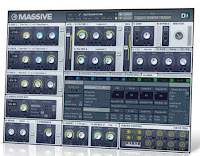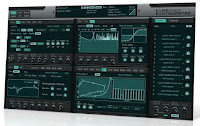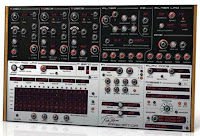#1. Native Instrument: Massive
The fact that Native Instruments have managed to get three of their synths onto this list is testament not only to the fact they know how to make great instruments, but also to the depth that these plugins offer. Massive perfectly epitomises this, and NI rightly call it the 'go-to choice for bass music and electro producers'.
Simply loading up its initialised setting delivers the edgy trademark sound that Massive is renowned for (trust us, you'll know it when you hear it), and by layering up three of these oscillators with octave offsets you're already well on the way to producing some seriously tough results - but that really is just the tip of the iceberg. Each selected wave is in fact a wavetable oscillator, combining at least two source waves. The Wt-Position controls enable you to morph from one wave shape to another - for the default wavetable oscillator 'Square-Saw I, for example, the Wt-Position control moves from square to saw. In use, changing the Wt-Position settings creates many combined shapes between the two extremes, and there's a choice of 85 wavetable oscillators including everything from typical pulse/sawtooth combinations to vocal effects and metallic sounds.
The three main oscillators are supplemented by a dedicated modulation oscillator (for ring. phase and position modulation) and a noise generator. The wavetable oscillator design also lends itself to dynamic sounds at the core level, as you can actually modulate the Wt-Position controls. So, you can see why Massive is great for very direct sounds, but also for direct sounds with some organic movement, should you wish.
Of course, being from Native Instruments, this powerful oscillator design is accompanied by a plethora of extras, including insert effects, master effects, an excellent patch browser and well-implemented twin filters. However, it's the modulation setup that's the gem here. Not only is it a simple-to-use drag-and-drop system, but four of the eight modulation sources can be allocated to LEO, stepper and performance modes, the last of these enabling the construction of excellent rhythmic modulations from a library of envelope shapes.
Web: www.native-instruments.com
Format: VST, AU RTAS, AAX, standalone
#2 KV331 Audio SynthMaster 2.5
Web: www.synthmaster.com
Format: VST, AU, RTAS
MusicRadar's 'Best Software Instrument of 2012' is a do-it-all synth with an attractive pricetag. The brainchild of Turkish developers KV331 Audio, over its six-year gestation period it's morphed from a PC-only VST instrument into the cross-platform v2.5 we have today - but throughout that time it's retained its core aim of offering multiple synthesis types in a semi-modular framework, flanked by an excellent range of effects.
However, to label SynthMaster purely an affordable jack of all trades is to miss the point by a pretty wide mark. This synth is deep, and has become progressively deeper with each version update. The result is a design not only bursting with presets (500 factory and a further 650 via the expansion pack) but full of programming flexibility for those who like to get their hands dirty.
Let's take a look at things in a bit more detail. SynthMaster uses a multipage interface that's functional rather than fancy, splitting the main screen into six pages (Layer 1, Layer 2, LFO, FX, Browser and Preset). Layers land 2 underpin its architecture, and each features two oscillators, two filters, four modulators and various envelopes, including multistage (up to 16 nodes). These feed into twin global effects busses. There's plenty of functionality at the root level, including multiple oscillator types (wavetable/virtual analogue, wave scanning, vector and additive), and each layer includes its own arpeggiator and five insert effects slots. There's a 64-slot modulation matrix and four LFOs, including user editable stepped and glide types.
This could all be a bit daunting for the new user, but it's all pretty logical, and there are of course lots of well-categorised presets, as well as access to the online preset library. And once you really dig into SynthMaster you'll find fantastic touches at every turn, offering enough flexibility to create truly impressive sounds, such as twin independent arpeggiators and a comb filtering mode for the filter. Oh, and then there are the two-dimensional multipoint envelopes, and the ability to add noise to the LEO output. All in all, SynthMaster is an incredible product at a great price that gives back what you put in and then some.
#3. LennarDigital: Sylenthl
Web: www.lennardigital.com
Format: VST, AU
Sylenthl appeared on the scene five years ago and pretty much blew the vast majority of subtractive synths out of the water. Delivering lots of analogue warmth, an upfront sound and liquid-sounding filters, it still produces great results today, and makes an ideal all-rounder synth. Packed with presets (over 1300) and with additional ones available free of charge, the €139 asking price is also very competitive.
So, what's included? There are four identical oscillator sections, each with up to eight-voice unison (so with all oscillators firing, that's effectively 32 voices per note). You can choose from eight oscillator waveforms, including three pulse options, random and noise, and each waveform has individual phase offset, pan and inverse settings. Unison is applied at oscillator level, along with detune and stereo spread. So, combining multiple oscillators with octave or other offsets can enable you to achieve massive sounds at source.
Sylenthl is also blessed with an extensive master effects section. Situated slap-bang in the middle of the interface, it offers eight tabbed pages for Arpeggiator, Distortion, Phaser, Chorus, EQ, Delay, Reverb and Compressor. Each effect is activated using the accompanying check box, so at a glance you can always see what's active. Overall, the effects are simple but can take an already great-sounding patch to the next level.
Sylenthis oscillators are arranged as two pairs (parts A and B) via two filters, and split across two tabbed pages. In workflow terms, this is the only chink in Sylenthis armour. but you can copy and paste settings. which speeds things up a bit. Also missing are the usual retro-influenced filter types, beyond the obvious high-, low- and band-pass. Even so, with individual filter saturation (drive) you can still conjure up some tasty filtering.
As noted, Sylenthl doesn't offer quite the depth of some of its competitors, but that doesn't seem to stop it from producing not only amazing sounds, but sounds that you can tweak with ease. Similarly, it's also simple to program from scratch, all of which makes it a great option for those after punchy, upfront sounds.
#4. FXpasion: DCAM: Synth Squad
Web: www.fxpasion.com
Format: AU, VST, RTAS
While the rest of our recommended synths adhere to an all-in-one design, DCAM: Synth Squad is the complete opposite, comprising a set of three totally individual synths connected by a master combo plugin called Fusor. The synths in question are named Strobe, Amber and Cypher, and each one addresses a different aspect of the analogue synth heritage.
Strobe is the simplest, with a typical subtractive design, but its single oscillator is still capable of simultaneously generating saw. pulse and noise waves, coupled with sine, triangle, saw and pulse sub-oscillators. Factor in five layers of oscillator stack with detune and you've already got rich, solid sounds without even firing up the Unison mode. The filters are also rather tasty (there are 22 types) and are designed to be driven hard, making Strobe ideal for screaming lead sounds too.
Amber is heavily influenced by the classic polyphonic ensemble synths, so it's unsurprising to find two slightly different oscillator sections: Synth and Ensemble. The Synth section passes through a regular multimode filter, while the Ensemble goes via a formant filter and chorus. Both signals are then combined at the output mixer. The result is rich pad and string machine-like textures.
Finally, Cypher handles the analogue FM end of the spectrum, and each of its three oscillators includes a Wave knob that sweeps smoothly from triangle via saw and square to pulse. Additionally, Oscillator 3 can frequency-modulate Oscillator 2, and the latter can modulate the waveshape of Oscillator 3. Add in various sync options to Oscillator 1 and you've got an analogue synth that can create digital sounds, though with the character of analogue oscillators. Rounding things off are two filters and two waveshapers, which you can position pre- or post-filter, and an overall analogue control for simulating circuit noise. Each of the synths also includes a categorised preset browser and many good presets.
We think you'll like the variable focus of these three separate synths. and when you consider the combined price, each one represents good value. And if you do want to combine them (complete with insert and auxiliary effects), there's always the Fusor shell.
#5. Rob Papen Predator
Web: www.robpapen.com
Format: VST, RTAS, AU
Rob Papen is responsible for some of the most respected soft synths available, including Albino, BLUE and, most recently, Blade, but its Predator that expresses what he does best. Packed with all manner of presets, filters and rich core oscillators, this is one of a handful of synths that can give even the best hardware a run for its money. However, when you first load it up, Predator appears almost deceptively straightforward. The top half handles the three oscillators, two multimode filters, filter LEO, amplifier section and main envelopes, while the bottom half includes three effects slots, pitch modulation LEO, Play mode, modulation matrix and arpeggiator.
So, what makes this seemingly run-of-the-mill design so good? First up, the oscillators. Not only have you got 128 waveforms to choose from (including spectral synthesis, additive, noise and analogue types), but each oscillator also has dedicated pulse width modulation and a dedicated PWM square sub-oscillator. Oscillators 2 and 3 can both be synced to Oscillator 1 and feature frequency, ring and phase modulation, so there's loads of potential for oscillator tweaking at root level.
Much of the rest of the layout is so straightforward that you might wonder how sound creation can be this easy, from the lovely, fluid-sounding filters and simple modulation slots to the powerful arpeggiator and other nice touches, such as chord memory with strum speed. In essence, Predator is a doddle to program. Maybe this explains the 3000+ presets, which thankfully are available from the full-window file manager, as well as directly in the interface, so you can get a better handle on what's available. Patches are categorised into many contemporary music styles, and the fundamental patch type is included in the name (bass, pad, lead, arp and so on), so you can use the Find option to locate the right type of sound. It's no less than we've come to expect from 'preset king' Rob Papen, but it's impressive all the same. And if all that really doesn't float your boat, you can always drum up some fresh sounds via the onboard Variation function.
#6. Native Instruments Razor
Web: www.native-instruments.com
Format: VST, AU, RTAS, AAX, standalone
Razor is a Reaktor-based additive synth designed by Berlin-based electronic music producer Errorsmith, and is arguably the most successful Reaktor ensemble yet. Its additive engine extends to 320 partials, and the manipulation of these partials at source achieves everything from filtering to detuning. The GUI is presented in traditional format, with two oscillators, two filters, three envelopes, two LFOs and three effects sections - though of course, you only have to scratch the surface to find all sorts of crazy oscillator shapes and filter types. Combine these with the effects section and you can conjure up everything from edgy sounds and effects to atmospheres and leads. But for us, it's the Safe Bass and Spectral Clip options that do the real business, helping to deliver deep, hard bass sounds to drive your track.
There's something wonderfully immediate about Razor, both in its punchy sound and in its quick, intuitive interface. Oh, and it's pretty good value too.
#7. Synapse Audio Software Dune
Web: www.synapse-audio.com
Format: VST, AU
On the face of it, Dune is just a regular subtractive synth, and with two main oscillators, a sub-oscillator. three LE0s, three envelopes, filter, arpeggiator, modulation matrix and effects, you may be asking why it's in our list. But through a combination of excellent patches, simple interface, flexible oscillators and a unison system called the Differential Unison Engine, it can conjure up some very big sounds.
This journey starts with the two main oscillators, which offer saw, pulse, sine or one of 69 wavetable shapes. Each oscillator then gets a Fat control, which turns it into a stack of seven oscillators (increasing the Fat control increases the detuning). Moving on to the unison section. you can then add up to eight-voice unison across all playing oscillators. So, factoring in the sub-oscillator, you have the potential for 120 oscillators per key. The final icing comes in the form of direct access via the modulation matrix to individual unison voices, enabling you to influence everything from pitch and panning to effects mix and filter cutoff. Wowsers.
#8. GForce Software impOSCar2
Web: www.gforcesoftware.com
Format: VST, AU, RTAS (Mac only), standalone
Renowned for their excellent software emulations of classic synths and love of all things retro, GForce Software have carved out an impressive niche for themselves. However, when they revisited their original OSCar synth emulation with a view to incorporating some user feedback, little did they know that they were about to create a modern classic all of its own.
The synth's main components are two digital oscillators, two LF05, twin filters, up to eight-voice unison, arpeggiator, effects, chord memory and patch browser (for the 1000+ patch library), but the devil really is in the detail here. First, in addition to the ten basic waveforms, there are two additive waveforms, which you can modify or create from scratch on the Additive Wave Matrix Grid. Also, rather than being totally separate, the twin filters work together in various serial or parallel configurations. These combine with cutoff, resonance, filter envelope modulation and filter drive to produce some pretty edgy sounds.
Unison is a new feature for impOSCar2 and is probably the single most important addition, offering up to eight stacked voices with manual detune, and spread control with panning options. If you're using Portamento or Glissando modes, you can also dial in some timing spread to the unison voices. All this is good news if you like creating big, rich sounds.
Finally, impOSCar2 can be used as an effects plugin via a dedicated insert version. This was one of the most requested options from users of impOSCar. and when you hear the filters you'll understand why. Rather than just grabbing the best bits for the effects plugin, it's actually the same plugin but with audio input set up as each oscillator.
There are a number of great things about impOSCar2, and in particular the combination of oscillators and filters just sound amazing. It's not a workhorse synth, but if you're after something special, it can deliver, particularly if you like deep, evolving sounds.
#9. u-he Diva
Web: www.u-he.com
Format: VST, AU
We can state without reservation that all of u-he's synths are excellent, but Diva's aim of giving you elements of classic hardware synths in a mix-and-match modular format, with no sonic compromise, sets it apart from pretty much all other soft synths on the market.
The design is pretty straightforward, much like the original hardware it apes. The top half of the interface carries the synth modules: oscillator section, high-pass filter, main filter, Envelopel and Envelope 2. There are four oscillator modules, four main filter modules, three envelope types and three high-pass filters, sourced from eight classic synths. Although the sources aren't listed. Minimoogs and Roland Junos are prime candidates. All this is coupled to a modern master section with two LF05, two effects, tuning and glide, and additional modulation (the filters already include direct access to modulation sources). It's a pretty heady mix that can be taxing on your CPU, although there are four quality settings to help cope with this.
#10. Native Instruments FM8
Web: www.native-instruments.com
Format: VST, AU, RTAS, AAX, standalone
The latest version of NI's DX7 emulation, FM8 is very much an elder statesman of the soft synth world. However, it certainly shouldn't be overlooked, as it takes Yamaha's original FM concept and supersizes the original six-operator sine wave system with 32 potential waveform types, and in the process massively expands its sonic palette.
For hardened programmers FMS includes excellent operator-level programming via its Expert page, but where it really shines is in its ability to diffuse the complexities of FM via its Easy Editor, and in its additional creative features such as the Arpeggiator, Effects Rack and Morph Square. This last option moves between the four timbral extremes of the patch and can be automated for expressive control, or you can randomise its position to create new sounds.
Alternatively you have freely adjustable envelopes with up to 32 stages, and matrix-based modulation for real-time parameter manipulation. And if that all sounds a bit daunting, the 1200 or so presets are of excellent quality.



















